I've wanted to visit Fenton House after seeing it used in the television adaption of Clarissa. Based on Samuel Richardson's novel, I first saw this mini-series in 1991 (the first time I ever cast eyes on the tasty Sean Bean, who played rogue Lovelace). I found it on YouTube circa 2019 and re-devoured it. I also recognised the house (its balconies are quite distinctive) in Ruth Rendell's A Dark Adapted Eye.
It almost seemed as if fate was transpiring against me- I wanted to visit for my birthday the next year, but it fell on a Saturday and the house doesn't open on Saturdays. Then we had lockdown and it was shut for quite some time. Then I did book but it was cancelled as the house had to close due to unforeseen circumstances. I finally made it very recently, travelling on my own as the SuperDean didn't feel up to it.
It's only a few minutes' picturesque walk from Hampstead Tube station, and I passed the pretty Grade II listed Holly Bush pub on the walk up the hill.
We were asked to do the gardens first. It was an hour before midday, so therefore very bright and hot. Sunglasses were required!
The shadows cast by the topiary trees on the north side of the house make for a very attractive photo.
The statue at the end of the sun-baked lawn is a painted lead shepherd...
Looking down from the walkway to sunken garden, with its topiary box hedges and herbaceous borders...
The sunken rose garden...
Thistles growing beside the high boundary wall...
The brick mansion dates back to 1693, with that date etched on its chimney breast...
...The date is consistent with the core of the house, and most of its walls.
Sheltered loveseat at the end of the upper walk. I did make a point of having a little sit down here!
The house was designed by William Eades, the son of a bricklayer. His taste was considered more artisan than architect and he used a minimum of carved stone, choosing to make warm red brick the main feature of this house, which is considered to be one of the finest in the area.
At the time large houses were being built in Hampstead for the affluent classes, as it was within close reach of London but away from the city's pollution and congestion.
Walking down into the sunken garden, and I adore the conical topiary hedge creations.
This is a rose garden, although there appeared to be other varieties of plant as well. Seats such as this wooden one feature a lot in the garden.
A wrought iron seat and this, I believe, is a herb garden...
There was an abundance of pretty, fragrant lavender...
The shepherd is on a Portland stone plinth, and he stands sentinel over the north lawn.
Leaving the manicured gardens, and here we have another little shaded seat...
Stepping into the neighbouring orchard- is it wrong that my first thought should be of a glass of cider?!🤔
The greenhouse was too warm to stay in for long!

The view down the walkway farthest from the house. To the left trees divide the sunken gardens from the orchard...
Walking up curved stairs into the next garden section...
The house was known in the early 18th century as Ostend House.
Eye-to-eye with the north side of the house, and you can get some idea of how relentless the recent weather had been from the state of the sun-baked lawn...
Ostend is a coastal city in Belgium, so the name suggests that the first owner had Flemish trading connections, and was a city merchant.
The topiary trees form the other direction, looking towards the stairs to the walkway...
Watering can and some other contraption, although I don't know what it's for. Possibly for attaching to fly spray? It has some kind of lever. Horticulture is not something I'm an expert on, although I enjoy wandering amongst the fruits of other people's devoted labours.😉(Note: A bit of Googly research and Facebook questioning has revealed that it's a window opening ratchet...)
I loved the wildness of the orchard; which stood in great juxtaposition to the carefully tended sections.
Over 30 varieties of apple grow here...

I took a crab apple back home as a gift for the SuperDean!😁
I love this bucolic shot, taken from the other end of the 300-year-old orchard. It was a boiling hot day, and I sat down on a bench for a while.
I believe this part is considered to be a kitchen garden- but with no-one living at the house it looks like it's been allowed to flourish as a flowering wilderness. You can walk into this section, and there's another little bench to have a sit down upon.
Lady Binning had an extension added to the west end of the house. It dates back to about 1936 and added about 5% extra to the property's size.
Lady Binning bought the house in 1936, but didn't spend much time here, even letting the previous tenant continue with their residency.
The tinkling sound of this water feature was very relaxing...
Looking over the high-level walkway across the orchard...
View down the high-level walkway- the sunken gardens and house are to the right...
Philip Fenton's parents were well-off, and he got even richer by being a successful Riga (the capital of Latvia) merchant, exporting Russian produce to London.
Beautiful view through the sunken gardens toward the house...
The merchant spent his retirement here, before dying in 1806. He was responsible for much of the remodelling.
This glorious view was my favourite photograph of the day...Walking round to the south side of the house, and here's a shed, wheelbarrow and what looks like another straggly compost heap...
This is the view down the original front path towards the gates...
This south side- with its pedimented door carried by Doric pilasters- was the original entrance, until James Fenton inherited the house in 1807...
Entrance hall, with an imposing grandfather clock. You can see up one of the sets of stairs- the other is to the right of this photo.
Downstairs room with its original marble fireplace...
Window seat...
Even the downstairs rooms have closets (where chamber pots would have been kept). It's an unusual feature, as normally closets were reserved for bedrooms!
My favourite inside photograph- a colourful selection of snuff bottles with a partially-obscured Vain Old Tart in the background.💜
Vain Old Tart above a small cabinet of treasures...
They are a collection of pill boxes...
The house's layout was originally a uniform cross shape with four equal sections, but James Fenton created a spacious dining room that ran along this side of the building by uniting the southside rooms.
Along with Lady Binning's collection of fine arts, needlework, furniture and ceramics, Fenton House also houses the Benton Fletcher Collection of historical keyboards and other musical instruments. These were acquired by the National Trust in 1937.
This is a Burkat Shudi harpsichord dating from 1769.
A very warm Vain Old Tart reflected in a mirror...😊
A majestic bookcase sits at the other end of the room...
Ceramics inside a decorative cabinet, and I quite like the cool greenness of the bowl and platter on the table...
Meissen porcelain figurines.
La ci Darem la Mano (Don Giovanni), 1860-1942, by Walter Sickert, RA (1860-1942).
Most rooms are graced with either a piano, harpsichord, spinet, clavichord or virginal, as well as interesting furniture such as this cane and walnut chair.
The long back rest did make me think of Charles Rennie Mackintosh, though!
View out onto the garden...
All the instruments are in working order and regular concerts are held here.
This is a Jacob Kirckman 1752 harpsichord.
Posture chair...
The textile box in the cabinet is called The Judgement of Paris (17th century).
Mahogany table with extension flap...
Toby jugs...
Embroidery...
Bedroom with a huge tapestry backdrop...
Johann Hancock spinet, dated somewhere between 1700-1799.
Blue and white vases abound...
Elegant Georgian room, and the wooden gilt mirror dates from 1765.
Corner secretion of ceramics, with larger cabinets holding more of these treasures to the right.
The glass box on top of the chest of drawers contains a ship.
Lady Binning's was certainly an avid collector of ceramics! Another view of more of these in cabinets...
I like the contrast of the Georgian décor with the modern tower fan!
The artefacts were were nicely arranged, and each room was well-thought-out.
Another eye catching piece, and this looks like a drinking vessel, as it appears to have double handles. Again, I like the cooling green colour (maybe that was something to do with the hot day?)
This attractive Chinese vase dates from anywhere between 1662-1722...
1735 Meissen teapot...
King James II (1633-1701) as Duke of York, aged 27, attributed to Simon Luttichuijs (1610-1661).
The embroidery is Esther and King Ahasuerus (date unknown.)
'Psyche,' a White Persian Cat, 1787, by Francis Sartorius (1734-1804).
One of the nicest features of the house was these little "closet chambers" off the main rooms- nowadays (I mean now that we no longer have to use chamber pots!) the perfect place to curl up with a good book.😊
A trio of blue and white vases- - shades of The Amazing Mr Blunden, methinks?!
Upstairs grandfather clock...
One of the two staircases, and you can see the pretty, cough candy twisted balusters...
Virginal, by Baffo (date unknown- given as anything between 1500-1699!)
We'll finish with the Vain Old Tart again, staring into a 19th century round mirror.
Fenton House gained Grade I listed status in 1950.
The east entrance- which James Fenton had created- is a colonnade between two projecting wings.
In the past it has been possible for the public to go up onto the balconies, but the top level was cordoned off when I was there, so that wasn't possible.
Nearby Whitestone Pond, with Jack Straw's Castle the white building in the background. I was going to wander over to Hampstead Heath, maybe take a look at the zoo there and see if the butterfly house was open- but it was a very hot day, I didn't have enough water with me and was not wearing the correct shoes, so I decided to abandon that idea.
Jack Straw's Castle is named after the Peasant's Revolt leader, who is said to have taken refuge on the site before being caught and executed in 1381. It's another Grade II listed building, existed as a pub from the early 18th century and was renovated in 1964, before being converted into flats in the early 21st century. Apparently the building's currently empty.
I will definitely return to this lovely area as there are other houses and tourist attractions I need to visit.
But, until then,
TTFN
The Miss Elaineous.
XXXXX
XXX
X
XXX
X






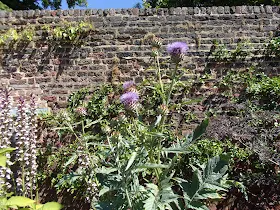






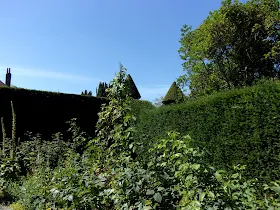
























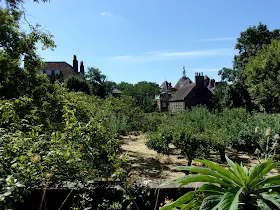









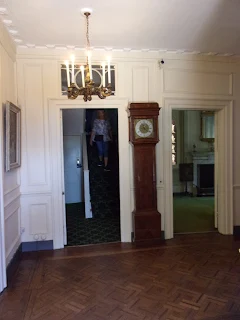








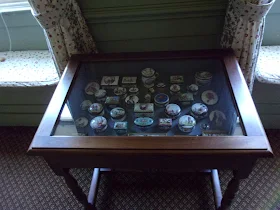

.JPG)















.JPG)
.JPG)








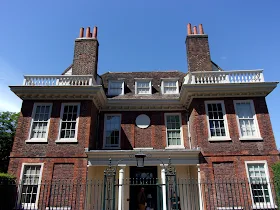


No comments:
Post a Comment